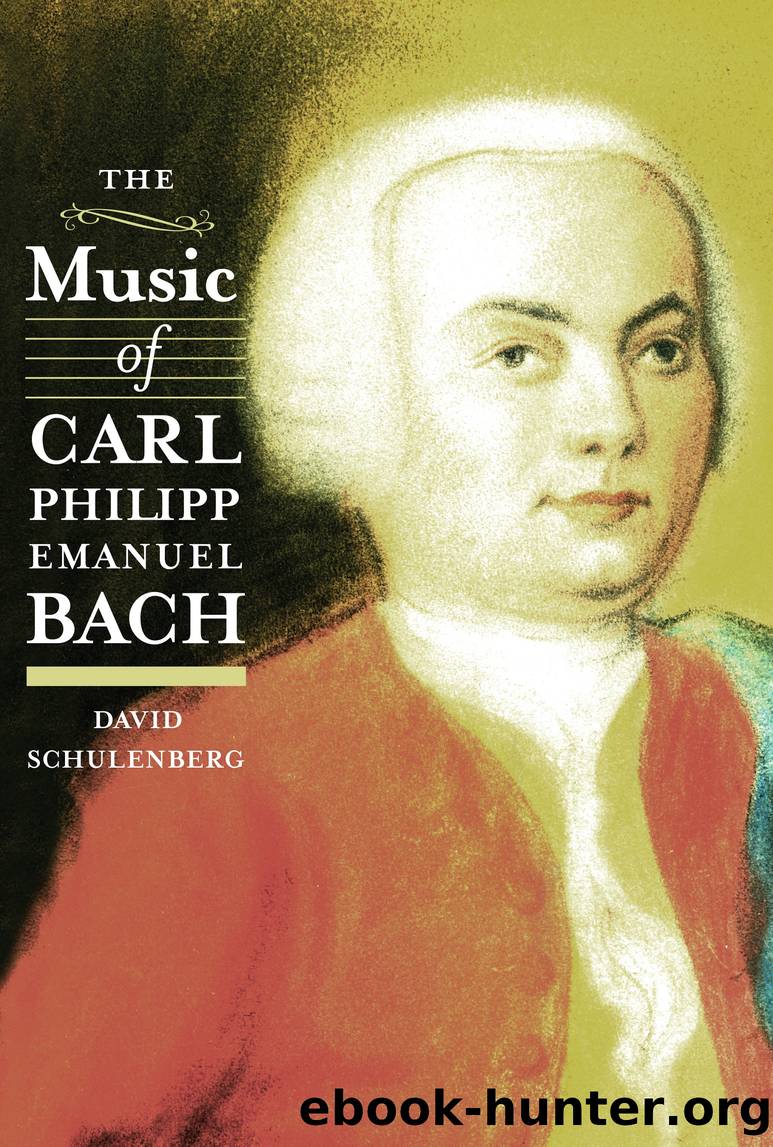The Music of Carl Philipp Emanuel Bach by David Schulenberg

Author:David Schulenberg [Schulenberg, David]
Language: eng
Format: epub
ISBN: 9781580468824
Publisher: Boydell & Brewer Group Ltd
Published: 2015-09-10T16:00:00+00:00
Sinfonias
The sinfonia or symphony was not, for Bach, the important genre that it became for members of following generations. Bach wrote sinfonias only occasionally, and the pieces themselves are smaller in both duration and musical substance than most of the symphonies of Haydn and later composers. Although Bach’s eighteen sinfonias span his entire career at Berlin and Hamburg, most were composed during two brief periods, the mid-1750s at Berlin and the mid-1770s at Hamburg. The ten written at Hamburg are the most important, closely related to and in some ways even more consistently creative than his late concertos; for this reason their consideration has been postponed until now.84
The sinfonia as Bach understood it was more tightly defined by local conventions than his sonatas and concertos, and all eighteen works follow the traditional formal plan. Apart from the unremarkable first sinfonia of 1741, Bach’s initial efforts in the genre date from a period when he was retreating from the more challenging aspects of his earlier music. Representing a type of music that had originated as a grand but superficial type of opera overture, the handful of sinfonias that he wrote during the mid-1750s pale by comparison to those of the next two decades. Yet none less than Hasse declared Bach’s E-Minor Sinfonia of 1756 (W. 177) the best he had ever heard; not merely its minor tonality but its expressive intensity is unusual for a sinfonia of its time.
This work, like all Bach’s sinfonias, was probably written for concert performances; all four sinfonias of the mid-1750s may have been performed in concerts sponsored by the queen and queen mother.85 That Bach nevertheless wrote relatively few sinfonias probably reflected limited demand for pieces of this type from someone best known for his keyboard music. Perhaps, too, Bach was cautious about writing within a genre that the Graun brothers, particularly Gottlieb, had made their own at Berlin. It is unlikely that he had any qualms about writing orchestral music as such, especially after composing what look like prepartory exercises in the two trio-sinfonias of 1754; the ritornellos in his Magnificat and in his concertos from around 1750 are already in the appropriate style and scoring. After he composed his eighth and last Berlin sinfonia in 1762, however, eleven years passed before Bach wrote another. Then, applying himself to the sinfonia as he had just done to the concerto with his 1771 set, he quickly produced six sinfonias for strings and continuo. These were followed three years later (in 1776) by the four Orchestral Sinfonias, so called from the title in Bach’s edition of 1780, which noted the inclusion of obbligato woodwind parts.
The soloistic writing for flutes, oboes, and bassoon in these last four sinfonias perhaps reflected the current vogue for the Parisian symphonie concertante, to which Christian Bach had been contributing for at least a decade. Emanuel also would have known the older tradition of the so-called group concerto, which, in examples by composers such as Pisendel and Quantz, had produced works that were called both concertos and sinfonias.
Download
This site does not store any files on its server. We only index and link to content provided by other sites. Please contact the content providers to delete copyright contents if any and email us, we'll remove relevant links or contents immediately.
| Classical | Country & Folk |
| Heavy Metal | Jazz |
| Pop | Punk |
| Rap & Hip-Hop | Rhythm & Blues |
| Rock |
Cecilia; Or, Memoirs of an Heiress — Volume 3 by Fanny Burney(30934)
Cecilia; Or, Memoirs of an Heiress — Volume 2 by Fanny Burney(30889)
Fanny Burney by Claire Harman(25784)
We're Going to Need More Wine by Gabrielle Union(18072)
Plagued by Fire by Paul Hendrickson(16636)
Cat's cradle by Kurt Vonnegut(13867)
Bombshells: Glamour Girls of a Lifetime by Sullivan Steve(13108)
All the Missing Girls by Megan Miranda(12747)
Leonardo da Vinci by Walter Isaacson(11903)
4 3 2 1: A Novel by Paul Auster(11049)
Adultolescence by Gabbie Hanna(8145)
The remains of the day by Kazuo Ishiguro(7551)
Note to Self by Connor Franta(7024)
Diary of a Player by Brad Paisley(6866)
Giovanni's Room by James Baldwin(5878)
What Does This Button Do? by Bruce Dickinson(5527)
Recovery by Russell Brand(4564)
Born a Crime by Trevor Noah(4511)
The Kite Runner by Khaled Hosseini(4435)
